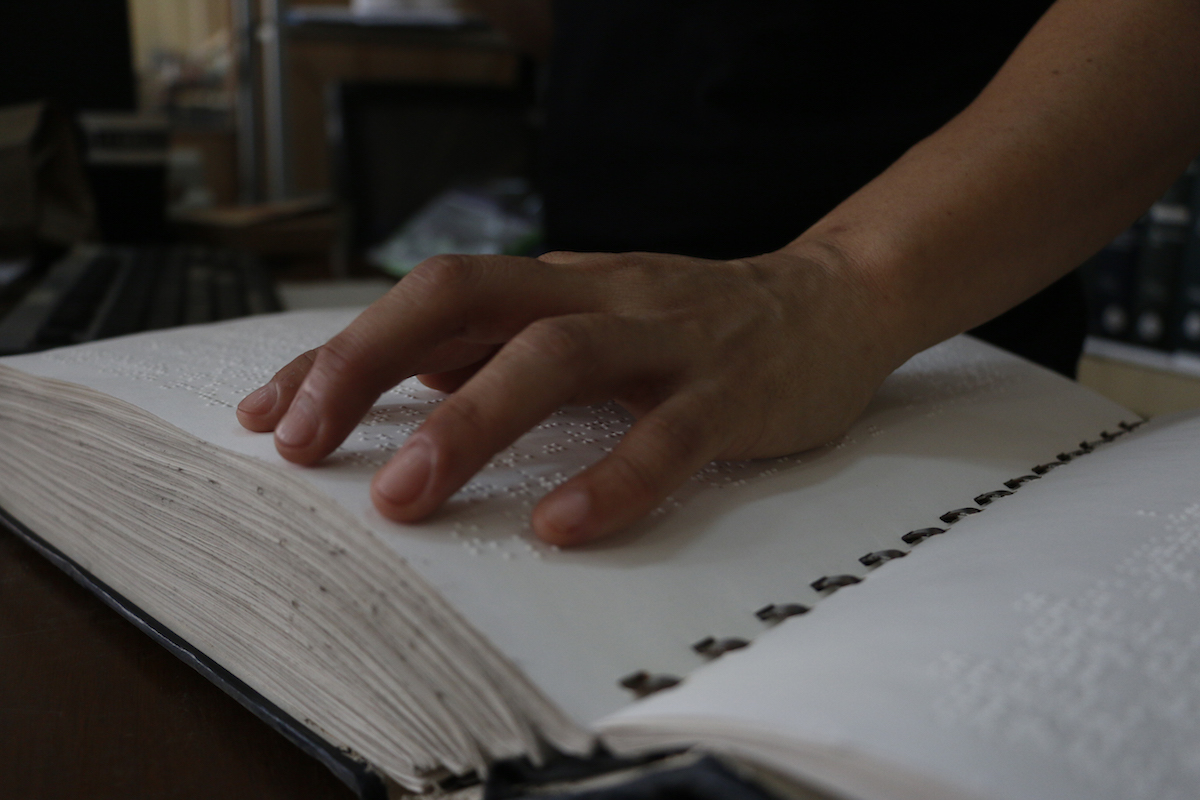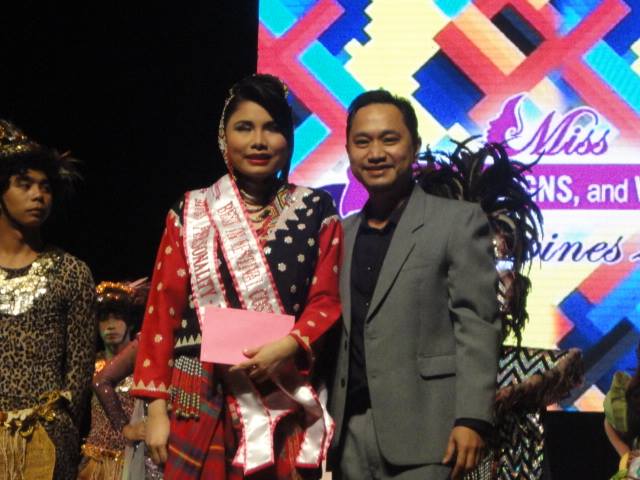[metaslider id=32572]
Text and photos by JHESSET THRINA O. ENANO
WHEN Ronald Manguiat was still studying at the Philippine Normal University (PNU) in Manila, the National Library of the Philippines (NLP) on T.M. Kalaw Avenue a few blocks away was his go-to place. He visited the library almost daily in his four years in college, relying heavily on its resources to help him in his studies in Secondary Education.
Manguiat was drawn to one particular section: an air-conditioned, 400-square-meter area on the ground floor of the West Wing. It’s the Library for the Blind Section (LBS), which has a Perkins brailler, or Braille typewriter with nine keys.
The services at LBS were important to Manguiat, a student with visual disability. PNU’s own library is still unequipped with resources for students who are blind or with low vision.
As he studied to be a teacher, Manguiat realized one glaring setback in the country’s official national library. The two-decade-old Library for the Blind lacks Filipiniana materials in accessible formats, such as in Braille and in large print, for people like him. This despite the mandate of the National Library as the “repository of the printed and recorded cultural heritage of the country” and its objective to “acquire and preserve Filipiniana materials.”
The deficiency applies not only to resources written in Filipino, but also to those about the Philippines itself. It reflects the state of development of accessible materials for people with visual impairment who, according to the 2000 census, comprise the biggest number of Filipinos with disabilities.
Dearth of accessible collection long a problem
The 128-year-old National Library has more than a million materials in its collection, most of them in Filipiniana. The Library for the Blind Section, previously the Division for the Blind, opened in 1995.
The section houses materials in Braille, large print and audio recording. It offers for free services such as borrowing of books, recording of printed materials to compact discs (CDs) or cassette tapes, and embossing or Braille printing.
Three years before the Library for the Blind Section opened, Republic Act No. 7277, the Magna Carta for Persons with Disabilities, was passed, providing for the establishment of Braille and Record libraries in provinces, cities or municipalities under the Department of Education (DepEd), then referred to as the Department of Education, Culture and Sports.
Despite R.A. 7277 law, LBS remains the only one of its kind in the country, NLP Reference Division chief Dolores Carungui said. (The section was moved to Carungui’s division in 2004 moved under the government’s rationalization program.) And that makes the scarcity of Filipiniana materials in accessible formats all the more worrisome.
The issue has plagued LBS since its establishment and is documented in reports to the International Federation of Librarians Associations and Institutions (IFLA) and the Conference of Directors of National Libraries in Asia and Oceania (CDNLAO).
The reports fault the insufficient local production of Braille and large print materials in Filipino, as the Library of the Blind Section lives off foreign donations.
In the Philippines, only two institutions produce materials in accessible formats for people with visual disability. The nongovernmental Resources for the Blind Inc. (RBI) produces them upon request. The Philippine Printing House for the Blind (PPHB), an agency under the DepEd, produces textbooks for special education schools, catering to elementary and high school students.
Relying on donations
The collection of LBS consists of mostly donations from RBI and PPHB, with more coming from RBI. Some materials are also given by the Xavier Society for the Blind, an organization based in New York. Donations from both RBI and Xavier Society are from abroad, mostly from unwanted collections from the United States.
“It’s automatic; once they discard materials, it goes straight to us,” said Mayette Regala, who is in charge of information technology and accessible digital publishing at RBI.
Regala, who is also the contact person of LBS, said the sources of donations include the Library of Congress, National Library Services for the Blind, American Printing House and American Action Fund, which, she said, send “discarded textbooks, dictionaries, encyclopedias.”
As a result, the foreign materials that find their way to LBS have old publication dates, and even older and more obscure titles. While fiction books like the Harry Potter series—one of the most in-demand titles in the section—can be timeless, nonfiction ones, such as textbooks and other educational materials, can contain obsolete information.
The last time RBI donated to the library was in 2012. According to the library’s annual report, there was no collection development for LBS in 2013.
Allan Mesoga, a graduate of PNU who, like Manguiat, has visual disability, recalled having borrowed a book on algebra from the Library for the Blind Section dating many years back.
“I think the copyright was 1969,” said Mesoga who now works as a proofreader in PPHB. “I borrowed the entire set because I needed it then.”
Hindrances to reproduction in Braille
The National Library is notable for being the home of the original manuscripts of Jose Rizal’s Noli Me Tangere and El Filibusterismo. As of this writing, LBS has Braille copies of both titles, as well as a copy of Pasyón.
These three titles, however, are the only Filipiniana materials LBS has and are dwarfed by hundreds more foreign titles. These copies were reproduced due to client requests. Afterwards, LBS decided to have copies of its own.
Carungui pointed to Republic Act No. 8293, the Intellectual Property Code of the Philippines, as one of the hindrances to the reproduction of Filipiniana materials in Braille and large print.
The 1997 law sets limitations on copyright, particularly on the reproduction and recording of copyrighted materials. Amendments passed in 2013, however, exempted from infringement the reproduction and distribution of materials for those with visual impairments, provided that these will be free of charge.
“Maybe we can now slowly address the issue on Filipiniana materials because now we can duplicate our (printed) Filipiniana collections,” Carungui said.
But Maria Lea Vilvar, the only blind librarian working in LBS and the entire library, said the law is not the only issue. A bigger, and more important, one is manpower.
“I want to produce. The problem is there is no one to encode,” said Vilvar, who has been with LBS since its inception. “They (NLP officials) assign different people to the section, but make them do different work.”
Four people are assigned to LBS: Vilvar, a sighted librarian, a support staff and Flordeliza Quinones, concurrent section chief and Reference Division deputy chief.
Braille production begins with the scanning of printed pages. The pages should be in full text format, to be edited and proofread. The pages are then converted to audio or Braille using a software such as the Duxbury Braille Translator, which translates pages in just one command.
LBS has two embossers or Braille printers called Romeo and Juliet. Romeo costs around P155,000 and prints 25 pages per minute on a single page. Juliet costs P200,000 and can print doubled sided, at 60 pages a minute.
Vilvar said Romeo was a donation, while Juliet was bought in 2012 by the NLP administration on her request.
While Vilvar can do the scanning, converting and embossing, her disability hinders her from editing and encoding the document herself, she said.
Donnalyn Hermosura, a sighted librarian who worked with Vilvar for 10 years in the section before she was moved to the Catalog Division, said editing is the critical stage of the production process.
“The edit should really be exact with the collection copy itself,” she said. “That really takes time.”
Dwindling collection, reader visits
The National Library is at present undergoing a massive retrofitting, which will run to 2018. The Reference Division closed in July 2014.
LBS was one of the earliest to close because of its location on the ground floor. Right now, only its embossing services are available. Most of its Braille collections are shelved in the main administrative area in the upper floors, while some are stocked elsewhere.
Quinones, section chief, said specific data on the number of collections are hard to obtain, especially since the construction began.
“We are doing an ongoing inventory,” she said. “While we don’t have readers yet, we organize first, do the inventory, go back to zero in the Online Public Access Catalog (OPAC).”
The collection has dwindled in the past years. The 1999 status report to IFLA showed the library had 922 Braille titles, 462 large print titles and 880 cassette titles. At present, LBS has 647 titles of Braille and large print combined, with 3,373 volumes of Braille materials and 1,099 in large print, Quinones said. She was not able to provide the data on audio recordings.
Quinones said the National Library has occasionally donated Braille books to other public libraries since 2011.
“When we weed out a material, following a specific criteria, we put it in the stock room,” she said. “If a library asks materials for their visually impaired clients, we give them as donation.”
The Quezon City Public Library main branch is one of the recipients. Located within the City Hall compound, the library has a small section for persons with disabilities (PWDs), consisting of a small shelf with materials for the disability sector such as handbooks and manuals.
The city library has two Braille books donated by LBS. One is titled Knitting without Tears. The other, The Heart is a Lonely Hunter, is the second of three volumes. The first and third volumes are nowhere to be seen.
“We can’t choose from donations they (LBS) give,” said Mary Ann Bernal, who is in charge of the section.
Meanwhile, reader visits to LBS have also gone down. There are days when it has no clients. In 2013, only 63 clients were served by LBS for different services.
“The collection needs to be updated. Sometimes, the client calls, but we don’t have the book or material they need,” Vilvar said. “They won’t go here. Why would they need to go here?”
While the collection is a letdown, the services offered by LBS are still necessary. Manguiat and Mesoga said they both used the services to get Braille copies and audio recordings of their class notes and research. When it was still open to the public, its audio recording service was in great demand because it is less meticulous than embossing.
Toward a PWD-friendly National Library
The scarcity of accessible materials is not lost on library users with visual impairment. It means they need to access other sections, such as the Filipiniana, for the materials that are not in LBS, then bring them to the section to have them converted to audio or Braille.
In Mesoga’s case, he had to buy the required college books in print, and have them converted or embossed either at LBS or RBI.
Carungui said the National Library is targeting the reopening of the Reference Division next year. She said plans are afoot to make LBS PWD-friendly.
“We want to serve not just those with visual impairment, but other disabilities as much as we can,” she said. “We need to improve not only the collection, but (we need) the staff to be capacitated on how to handle PWDs. The facilities should also be adjusted,” Carungui said.
Manguiat said greater government support is needed to develop LBS. “We need more materials, latest gadgets for the needs of blind people, new books, and a much bigger area,” he said.
Now a teacher at the Philippine National School for the Blind, Manguiat said he recommends LBS to his students despite its shortcomings. “The library is still a good help to them,” he said.
(The author graduated last June with a journalism degree from the University of the Philippines-Diliman. She submitted this story for the journalism seminar class “Reporting on Persons with Disabilities” under VERA Files trustee Yvonne T. Chua.)

